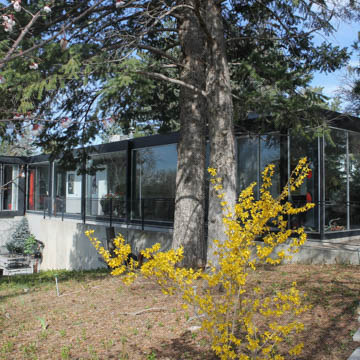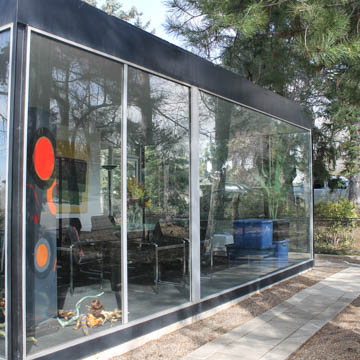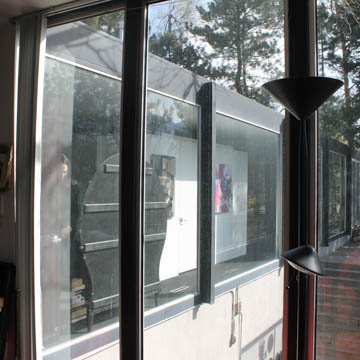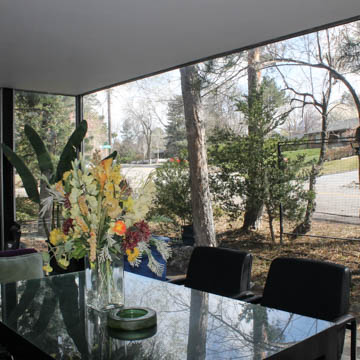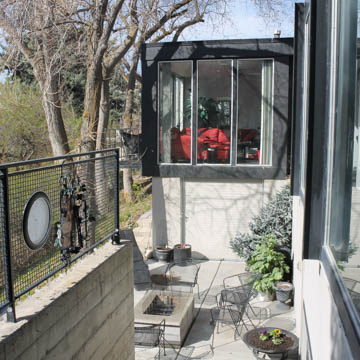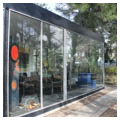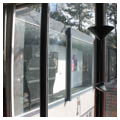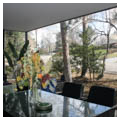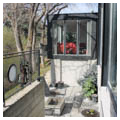The Roberta Sugden House was designed by one of Utah’s most influential modern architects, John W. Sugden, FAIA (1922–2003), for his mother. It belongs to the large body of glass houses built after Philip Johnson’s 1949 Glass House in Connecticut and Mies van der Rohe’s 1951 Farnsworth House in Illinois. Mies had conceptualized the glass house as a universal form, suitable for any function or location. Sugden translated it into a one-bed, one-bath, single-family home for his mother.
Sugden’s translation of this architectural form was grounded in his training. He had studied under Mies van der Rohe and Ludwig Hilberseimer at the Illinois Institute of Technology and had even worked on Farnsworth House as a draftsman in Mies’s office. After returning to Utah, Sugden became a forceful promoter of Mies’s approach to modern architecture, beginning with his mother’s house. He did his own experiments with steel and glass, simple detailing, geometric rigor, and bold designs in residential, commercial, and industrial projects.
The Roberta Sugden House encompasses both the demands of a real house and a Miesian emphasis on the ideal. It suppresses personal need in order to distill the modern house into a transparent and abstract space. This is registered in a delicately rendered box made out of glass, steel, and concrete. An opaque service core at the center of the plan separates the private and public zones. Fourteen wide-flange steel columns, seven on each side, support the steel-framed roof. Large, single-pane glass panels enclose the house. The vertical and horizontal steel members were originally painted white, but have since been painted black. Two porches flanked the shorter sides. One of these served as a carport, the other as an entry veranda. In 1970 these were enclosed, and an additional room was added at the back, giving the original rectangular plan an L-shaped footprint.
The house is sited on steep land in a dense suburb. With neighbors in close proximity, a brick partition wall along the adjacent property and another between the carport and the bedroom provided some privacy. But privacy was not a concern elsewhere. One enters the house by walking along the entire length of the exterior glass wall, passing by the bedroom, the service core, the kitchen, and the living room, visually surveying the house before entering on the opposite end. The house rises from the mountainous terrain on its concrete foundation/plinth. At the rear, this plinth acts as a bridge spanning two steep contours. Steel wide-flange columns also act as mullions to encase the glass walls. Avoiding contact with the ground, the columns parade their ornamental value. None of the exterior walls here hold the roof; freed from their structural duties, they now oblige only spatial demarcations. At the rear of the main house was Sugden’s detached office, tucked deep into the ground on three sides and lit by skylights and a fully glazed facade.
The architect designed the landscape, now mature, less as a setting to be contemplated and more as a necessary, and integral, element of the architectural scheme. Vegetation served as a means of obstructing vision; it mitigates the transparency of the walls. The meandering walkways, natural contours, and informal planting choreograph a dance between the machine and the garden. They generate a dialectic, not between the inside and the outside, because these traditional categories are barely appropriate in this context, but between the geometric and the picturesque.
References
Mooney, Anne. “A Fresh Look at Modernism through the Architecture of John Sugden (1922–2003).” Utah Preservation (2006).

